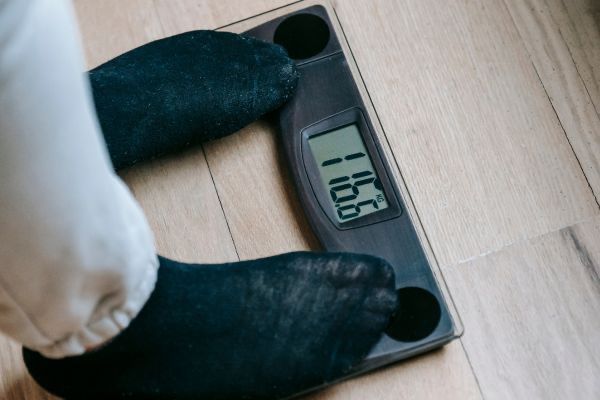
Overcoming Weight Loss Plateau
1- Understanding Weight Loss Plateaus
A major point that people need to understand is the principle of metabolic adaptation. As interpreted by Dr. Aronne, who is a specialist in obesity, this term stands for the body’s physiological, natural reaction to the dieting procedure, which in many ways goes against weight loss. The term describes how with any decrease in calorie consumption, the body adapts to this change by reducing the rate at which the metabolism functions. This is established with modern brain imaging investigations, where it has been found that in response to the drop in glucose levels in the bloodstream, brain activity decreases in the hypothalamus area. This is often referred to as the weight thermostat, as the hypothalamus membrane is responsible for overseeing the brain’s regulation of metabolism.
The hypothalamus regulates muscle tissue glucose absorption during food consumption,
Furthermore, it is known that when the body is in the process of consuming food, the hypothalamus stimulates tissues like muscle to absorb large amounts of glucose so that they can produce energy quickly. However, when the body starts to go without food, the brain stimulates the release of stored fat. This in turn triggers the nutrient signaling system, where hormone and fatty acid levels in the blood are regulated at a specific level and these have an impact on the activity of the hypothalamus.
2- Evaluating Your Current Diet Plan for Weight Loss
Write down your daily eating habits, including meals, snacks, and timing.
First, write down your actual daily eating habits. Go through your daily routine slowly, writing down the meals and snacks you consume each day and the actual timing of every meal. Jot down as many details as possible, including the different cooking methods and portion size of the item you consumed. After that, try to identify any trouble spots which you may find.
Any missing meal or snack? Is there any unusual food timing? Is there any meal that is loaded with calories? This step is extremely important because small little mistakes in your meal may render your diet plan useless. Then, evaluate the necessary improvements you can make to help yourself slim down faster.
If you struggle with controlling supper cravings, swap it for a low-calorie option.
For example, if you realize that you cannot control the temptation of taking supper, then try to swap your supper with something that is low in calorie. If you acknowledge that you have been drinking high calorie carbonated drinks, try to drink more water and eliminate those unhealthy drinks from your diet plan. Also, do not try to make too many adjustments in one go else you will not be able to cope with it.
Implement a few adjustments and slowly progress over a period. Lastly, ask for professional advice from dietitians, nutritionists, or personal doctor that what they view on your diet plan are. They are the professionals that can help you to make better decision to achieve your goal. Also, he or she could provide support and monitoring as you progress in your weight loss plan. These can be extra confidence for you to work on the plan.
Strategies to Break Through the Plateau
Starting off the exercise routine by increasing the intensity. This means that if someone used to walk for 30 minutes daily, then switch it up by running for an added 20 minutes and notice the difference this change will create. Another vital strategy is to check on the portion sizes of the food being consumed. Cut down on portions of food that contains a lot of calories, and this will not only make the process of shedding excess weight a reality, but it will also prevent possible relapse in the future. To effectively make use of this strategy, it is best to eat smaller portions of meals at least an hour before any work out session.
To break through a weight loss plateau, the body needs a variety of nutrients.
Also, diversifying the nutrient content of the daily meals is very important. For the body to break through the weight loss plateau, it requires a great deal of nutrients that can only be acquired from consuming a variety of food. Instead of relying on the traditional food eaten, seek alternatives and one will start noticing a change for the better. Incorporating more natural and fresh organic foods can easily form part of this strategy and with time the body will overcome the resistance to weight loss.
Some people tend to think that exclusion of meals in their daily routines can easily help them to get over the huddle and burn excess fat. This is far from the truth as it only makes the body to resist any form of weight loss. In fact, it is much easier to get through the plateau by consuming more meals but in smaller portions than skipping any given meal in a day.
While trying to break the weight loss plateau, be patient with the changes.
While it is important to incorporate the different strategies to breaking the weight loss plateau, it is also good for individuals to remain patient as the changes start to happen. Every strategy selected to try and get over the plateau should be well implemented, and the changes being observed keenly. If for any case a given strategy does not seem to work out, do not hesitate to try another strategy. Over time and with the right frame of mind, the body can easily break the plateau and lose more weight.
3- Adjusting Your Exercise Routine
Another way to overcome weight loss plateau is by adjusting your exercise routine. If you are the type of person who performs a cardiac workout on Monday, Wednesday, and Friday, it is time to change. Experts recommend that to overcome weight loss plateau, you should change the intensity and duration of your workout.
If you have been performing a fifteen-minute workout, increase it to twenty minutes and increase the intensity as well. Additionally, you may want to include weightlifting and performance of strength training exercises. Performing a low-intensity workout in the morning and a twenty-minute high-intensity workout in the evening.
adjust your calorie intake to match with the burned calories.
If you had been consuming 1900 calories a day, start consuming at least 2200 calories. The trick here is that by consuming more calories, your metabolism rate will increase, thereby tricking your body to release more fat-burning hormones which in turn leads to weight loss. Also, make it a habit of consuming frequent small meals as this helps to increase the rate of your metabolism. Try to feed after every three hours and you will soon realize that you are able to overcome weight loss plateau. With all said and done, the most important thing is to keep the motivation. Try as much as possible to consult and work with weight loss experts.
Keep on investigating various methods and discover the most comfortable one for you. You should not let yourself be overcome by weight loss plateau but instead change your routine and continue with the weight loss. And as you do so, remember that the only sustainable weight loss comes from a modest calorie restriction. Remember not to crash diet because this may bring in nutritional deficiencies and other health complications.
4- Maintaining Long-Term Weight Loss Success
Most people who are trying to lose weight can maintain their weight if they plan how to do it. It is a good practice to have a food diary as it helps to find out the mistakes that are made. Keeping a food diary and writing down what was eaten at each meal, and what time it was eaten and feelings that went along with eating, may help identify the problem plus when it happened. Also, whenever a person realizes that they are starting to regain the lost weight, it is important to try to re-lose the weight as soon as possible.
Moderate physical activity
Research has found that people who have lost weight and kept it off tend to be even more successful when they have a slip-up. Also recommends maintaining weight, a person should engage in at least 60 minutes of moderate-intensity activity on most days of the week. This may sound like a lot, but besides weight management, there are good reasons that a person should be active. First, moderate physical activity helps to maintain weight. Second, it helps to achieve and sustain weight loss and muscle tissue can be preserved when there is a loss of weight. Also, it helps to improve one’s mood and even self-esteem.
On the other hand, people are recommended to engage in more intense activities probably for 20-30 minutes on at least three days a week. Moderately intense physical activities are those exercises that a person could talk but not sing while doing. Such activities may include brisk walking, mowing the lawn, dancing, swimming, and bicycling and to name but a few. On the other hand, much intense activities can be those exercises that a person cannot talk while doing. Such activities may comprise of jogging, walking quickly, aerobic and doing heavy lifting. It is important to note that eating in response to emotions can increase weight and sabotage weight-loss attempts.
A good diet and exercise are key for long-term weight management.
Establishing a very good healthier eating plan plus regular physical activity can be the best successful strategies for long-term weight management. Also, it is good to keep in mind that successful weight loss will be determined by the ability to keep and maintain the changes in a lifestyle. Success is not just by achieving the set target but by keeping lifetime healthy choices. The set plans depend on the individual goals and a person’s starting point. For example, a person will need to work harder to achieve a weight loss of 10% of the baseline weight.
On the other hand, a small weight loss of 5-10% is clinically proven to help and improve overweight-related health risks such as gaining better control of diabetes and even having fewer heart attack and stroke cases. This is according to research, however, suggests that a person can start with as little as 10 minutes of physical activity and slowly increase because even that small amount of weight and physical activity can begin to help the health of the heart and improve the way a person feels. She also shed some light on dieting and that a person can lose weight if they are taking in fewer calories than what they burn.
Adjust calorie intake to new weight for long-term weight loss.
Dr. Wing explained that as the body weight goes down, it will require fewer calories per day to maintain the new lower weight. This is a great secret that fuels progressive and long-term weight loss as the calorie budget of each day will need to be adjusted to suit into the new lower weight. She suggests that food should be low in fat and high in carbohydrates plus it should be moderate to small portions. Also, if one is taking more calories than required, they will be stored in the body as fat and so will undo the hard work of losing weight. Such is the good advice and therapy work, and healthy living habits will protect patients from excessive calorie intake and further sabotage of their physical activity.
How do you break a weight loss plateau?
How do you fix a weight loss plateau?
References:
- Kim, J. Y. (2021). Optimal diet strategies for weight loss and weight loss maintenance. Journal of obesity & metabolic syndrome(1)
- Ruiz-Castellano, C., Espinar, S., Contreras, C., Mata, F., Aragon, A. A., & Martínez-Sanz, J. M. (2021). Achieving an optimal fat loss phase in resistance-trained athletes: A narrative review. Nutrients, 13(9), 3255(2)
- Bray, G. A. & Ryan, D. H. (). Evidence‐based weight loss interventions: individualized treatment options to maximize patient outcomes. Diabetes(3)
- Monnier, L., Schlienger, J. L., Colette, C., & Bonnet, F. (2021). The obesity treatment dilemma: Why dieting is both the answer and the problem? A mechanistic overview. Diabetes & metabolism.(4)
- Reljic, D., Frenk, F., Herrmann, H. J., Neurath, M. F., & Zopf, Y. (2020). Low-volume high-intensity interval training improves cardiometabolic health, work ability and well-being in severely obese individuals: A randomized-controlled trial sub-study. Journal of Translational Medicine, 18(1), 1-15 (5)
- Cavalcanti-de-Albuquerque, J. P., & Donato Jr, J. (2021). Rolling out physical exercise and energy homeostasis: focus on hypothalamic circuitries. Frontiers in Neuroendocrinology, 63, 100944 (6)
- Escalante, G., Campbell, B. I., & Norton, L. (2020). Effectiveness of diet refeeds and diet breaks as a precontest strategy. Strength & Conditioning Journal, 42(5), 102-107 (7)
- Steele, J., Fisher, J. P., Giessing, J., Androulakis-Korakakis, P., Wolf, M., Kroeske, B., & Reuters, R. (2023). Long-term time-course of strength adaptation to minimal dose resistance training through retrospective longitudinal growth modeling. Research Quarterly for Exercise and Sport, 94(4), 913-930 (8)



Pingback: How do you break a weight loss plateau?
Pingback: What drinks suppress your appetite?